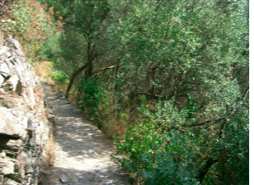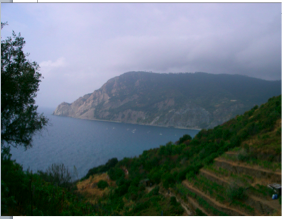Part III. Italy
Chapter 40. Crossing the Mountain [December 25, 1347]
Cultural Explanations
 |
Part III. Italy Chapter 40. Crossing the Mountain [December 25, 1347] Cultural Explanations |
|
 |
In this chapter Bávlos tells Maddalena about Stállu |
| Stállu and Sámi girl |
In this chapter, Bávlos entertains his guide with some stories as they climb over the coastal mountain toward the village where Maddalena lives. In the story, Bávlos's limited capabilities in Italian do not deter him from telling fairly elaborate tales. In real life, Bávlos would have had to act out many of the details to get his point across, and even then, it would not be certain that Maddalena would understand him. The chapter is told from Bávlos's point of view, however, in which he imagines himself fully competent in the new language almost immediately.
 |
 |
| Mountain pathway through an olive grove, between Vernazza and Corniglia | View of the sea from the mountainside between Vernazza and Corniglia |
The stories which Bávlos recounts are traditional Sámi tales of Stállu. The versions included here are typical of late nineteenth-century narrations as collected by folklorists such as J. Qvigstad. Although a fearful figure with cannibalistic tendencies, Stállu is also often a comic figure: ludicrously stupid and easily duped. The notion that some families had Stállu in their backgrounds is also traditional and was used to explain families that seemed somehow peculiar—either in terms of size and appearance or in skills like hunting and trapping. If you would like to read more about Stállu, read Coppélie Cocq's study Revoicing Sámi Narratives: Sámi Storytelling at the Turn of the 20th Century (Umeå: Umeå University, 2008).
Bávlos's image of Stállu matches the way in which the ogre is often depicted on Sámi drumheads. The image is placed up in the Sámi portion of the drum rather than down in the area corresponding to Bávlos's travels through Italy. Bávlos thus locates Stállu in his homeland rather than in any of the new places he is visiting.